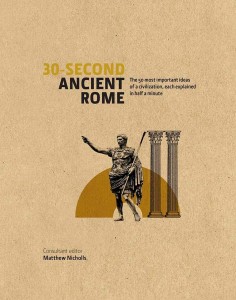A blog post from Dr Matthew Nicholls
I’m delighted to announce the publication of ‘30-second ancient Rome’, a compact guide to fifty of the most important topics and people in ancient Roman history. This has been published as a handsome (but inexpensive) hardback by Ivy Press, and should, I hope, be of interest to anyone who wants to know a bit more about the Romans.
Putting the book together was a really enjoyable process. The format was set by the press, who have a whole series of these 30-second guides – my Rome book takes its place alongside introductions to architecture, mythology, anatomy, and so on, each following the same template (though strangely J.R.R. Tolkein was upgraded to a ‘three-minute guide’ – there are some things that resist simplification; happily the entirety of Roman history is not one of them).
My first task was to choose the fifty entries. As our third-year dissertation students will know, the challenge in such an exercise is not what to put in, but what to leave out. Some topics were obvious enough, and the Press was understandably keen to see, for instance, entries on the legions and gladiatorial combat. For my part, I wanted the book to reflect something of the breadth of approach that a Classics department like ours brings to the study of an entire civilisation: one of the attractions of Classics as a subject is the chance to combine literary, historical, archaeological and other material. I also wanted the book to surprise or intrigue its readers as well as covering more familiar ground.
As the format called for seven chapters, I decided to group material into broad categories: a more or less chronologically organised opening chapter on the foundation and growth of Rome; chapters on social history and daily life topics; a section on language and literature and another on religion; and finally two chapters about art, architecture, monuments, and technology. Each chapter also includes a biography of a figure of particular relevance. Resisting the temptation to include the biography of Augustus in every chapter, I had fun thinking of suitable individuals.
Gradually the list of topics took shape, and then I had the enjoyable task of asking colleagues who are experts in each field to write the entries with me. With the honourable exception of Ailsa Hunt in Cambridge who kindly wrote the whole religion chapter, I was able to find current, past, and even (by an act of prescience) one future Reading colleague to share their wide-ranging expertise, so you will find entries by Susanne Turner, Dunstan Lowe, Peter Kruschwitz, Annalisa Marzano, and Luke Houghton.
I wrote most of the entries myself, though, and in doing so enjoyed the unusual discipline of writing for a general audience to a very tightly-controlled word count. The series is called the 30-second guides as the main entry on each page is meant to take no longer than that to read. This is a very different sort of writing to normal academic prose, which is statelier in its pace and rich in footnotes and detail; I found that it required real care to compress the maximum number of facts into a short compass, and writing in this way was an agreeable technical challenge.
By the time the entries were complete I was also working on the glossaries that accompany each chapter and consulting with the Press on illustrations – I managed to find a place for a couple of pictures from my own digital Rome model, not to mention my photos of various corners of the Roman world. I was particularly pleased that alongside all the things you’d expect in an introductory guide, we managed to fit in more recondite material including a chapter on
concrete and mentions – however brief – of porridge, jurisprudence, fish sauce, jokey tombstones, public libraries and – best of all – Sterculius, god of manure. As I wrote in the introduction, ‘all roads led to Rome, and we hope that this book will also take you there, by a variety of different routes.’


